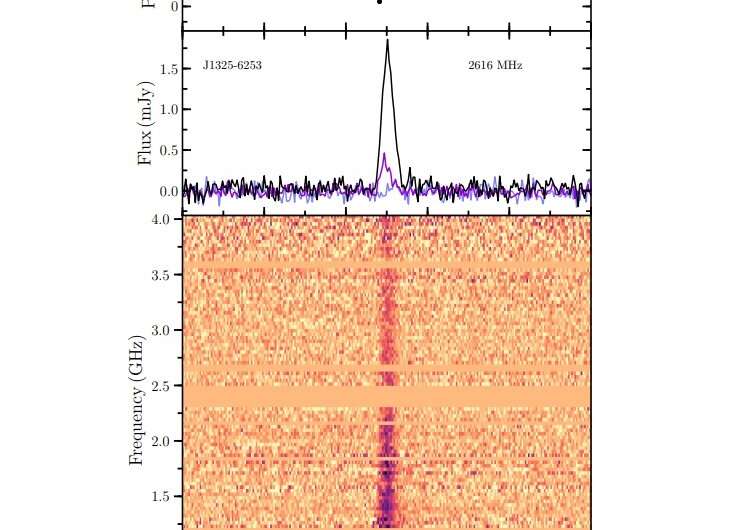The bottom panel shows the frequency-phase plot of PSR J1325−6253 across a large portion of UWL band (1,200–4,000 MHz), obtained by a 7.4-h observation. The top panel represents position angle (PA) in the leading edge of the pulse profile derived from the linearly polarized flux. Credit: Sengar et al, 2022
An international team of astronomers reports the discovery of a rare double neutron star millisecond pulsar. The newfound binary pulsar, designated PSR J1325−6253, consists of two neutron stars orbiting one another every 1.8 days. The finding is detailed in a paper published April 14 on arXiv.org.
The most rapidly rotating pulsars, those with rotation periods below 30 milliseconds, are known as millisecond pulsars (MSPs). It is assumed that they are formed in binary systems when the initially more massive component turns into a neutron star that is then spun-up due to accretion of matter from the secondary star.
Some pulsars consist of two neutron stars (dubbed double neutron star systems—DNS). They are one of the most important classes of objects used to test and understand numerous astrophysical and fundamental physics phenomena, including general relativity in the strong-field regime.
To date only 21 DNS pulsars have been identified, and now astronomers led by Rahul Sengar of the Swinburne University of Technology in Australia report the newest addition to this short list of these objects—PSR J1325−6253. The source was detected in a reprocessing of the High Time Resolution Universe South Low Latitude (HTRU-S LowLat) pulsar survey.
"PSR J1325−6253 was discovered in a GPU accelerated reprocessing of the HTRU-S LowLat survey (Sengar et al, in preparation) which employs the time-domain resampling method (Johnston et al 1992b) to search for binary pulsars. In this reprocessing, the 72 minutes of the full-time resolution data were searched coherently with a series of constant acceleration trials between ±50 ms−2," the researchers explained.
The study found that PSR J1325−6253 is a binary MSP with a spin period of 28.9 ms and orbital period of 1.81 days. Given that the binary has low but significant orbital eccentricity (0.064), a recycled nature and a high total mass (about 2.57 solar masses), the astronomers suppose that the companion object is likely another neutron star, with a mass of around 1.2 solar masses.
According to the study, PSR J1325−6253 has a dispersion measure of about 303.3 pc/cm3 and spin-down luminosity of 78 nonillion erg/s. The characteristic age of this pulsar was found to be 0.94 billion years, while the distance to this object was measured to be at least 14,300 light years.
Summing up the results, the researchers underlined that the orbital eccentricity of PSR J1325−6253 is the lowest among any known DNS system in a wide orbit, and second lowest after PSR J1946+2052. They noted that such low eccentricity along with the relatively wide orbit of PSR J1325−6253 strongly suggests that this DNS is a result of an ultra-stripped electron-capture supernova explosion.
"The existing orbital period of 1.81 days and low eccentricity for J1325−6253 mean that prior to the explosion the orbital period was probably only marginally shorter," the authors of the paper concluded.
More information: R. Sengar et al, The High Time Resolution Universe Pulsar Survey—XVII. PSR J1325−6253, a low eccentricity double neutron star system from an ultra-stripped supernova. arXiv:2204.06869v1 [astro-ph.HE], arxiv.org/abs/2204.06869
© 2022 Science X Network
























